Picture this: you’re in a workshop, trying to automate a process that could save your business time and money, but all you’re encountering are traditional solutions that just don’t cut it. Why do failures always occur during installation? If you’re feeling frustrated, you’re not alone. Electric linear actuators can often seem daunting—but here’s the good news: they’re incredible tools meant to streamline your tasks. With their rise in popularity for various applications, understanding how they work can benefit numerous industries.

Flaws in Traditional Solutions
Let’s face it—traditional hydraulic and pneumatic actuators often come with a host of challenges. Think about it: oil leaks, high energy costs, and maintenance headaches. These solutions are not just cumbersome but can lead to project delays and increased costs. In an age where efficiency is king, relying on outdated technology can be a huge setback. No one wants to deal with the aftermath of a system failure when innovation is right in front of us.

The Principles of New Technology
Now, let’s break down what makes electric linear actuators so special. At their core, these devices convert electrical energy into mechanical motion. This technology not only eliminates the complexities associated with fluids and pressure systems but also offers precise control. In fact, the use of electric linear actuators enhances system efficiency and is often more environmentally friendly due to their reduced energy use and lower emissions. They’re the unsung heroes of modern automation.
Quantified User Benefits
When it comes to real-world applications, the benefits are truly impressive. With electric linear actuators, industries report a 30% improvement in efficiency compared to traditional forms. Plus, they require significantly less maintenance, resulting in lower operating costs. Users also love how easy it is to integrate these actuators with existing systems—look, it’s simpler than you think! So, why not opt for technology that not only meets your needs but exceeds them?
Conclusion: Evaluating Your Options
Before you dive into making a purchase, always verify these 3 metrics when choosing solutions: ① compatibility with your existing systems ② energy efficiency ratings ③ ease of installation. Armed with this information, you can confidently choose the right actuator that will not only enhance your project’s efficiency but also save you headaches down the line.
Embracing Linear Actuators Electric
As previously mentioned, the integration of linear actuator electric into your projects can truly revolutionize operations. Unlike traditional actuators, they offer flexibility and durability that stand the test of time. Often equipped with smart technology, these devices can be easily controlled via software, making them more user-friendly than ever. The adaptability they provide means modifications to your designs are painless—plug and play, if you will.
The Advantages of Linear Electric Actuators
When considering automation, linear electric actuators might be your best bet. Their precision and reliability make them ideal for applications ranging from robotics to automotive. Isn’t that compelling? With advancements in technology, these actuators now deliver high performance with minimal energy consumption. Users often report a seamless operational experience, which translates into higher productivity and efficiency—who wouldn’t want that?
In conclusion, the advantages of implementing innovative solutions like electric linear actuators cannot be overlooked. The benefits they bring to various industries make them a go-to choice for ensuring efficiency and cost-effectiveness. For those looking for a reliable partner in this technology, look no further than DH-Robotics, a manufacturer that not only supplies top-of-the-line products but also backs them up with exceptional service. Your automation goals may just be a click away!
